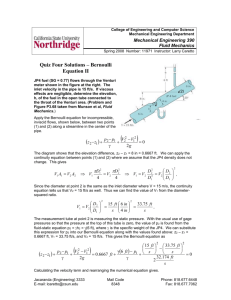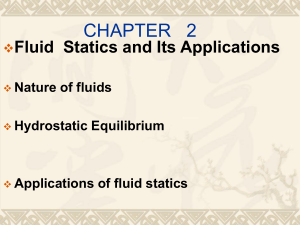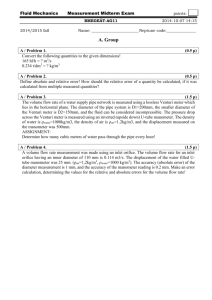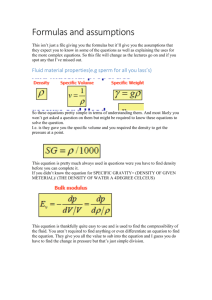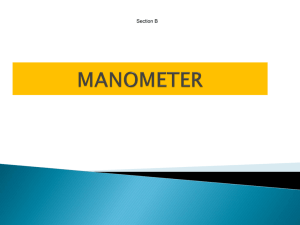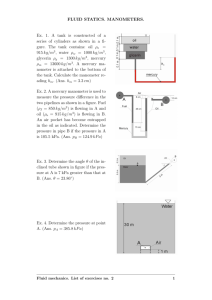3-4 Pressure and Measuring Devices 1
advertisement
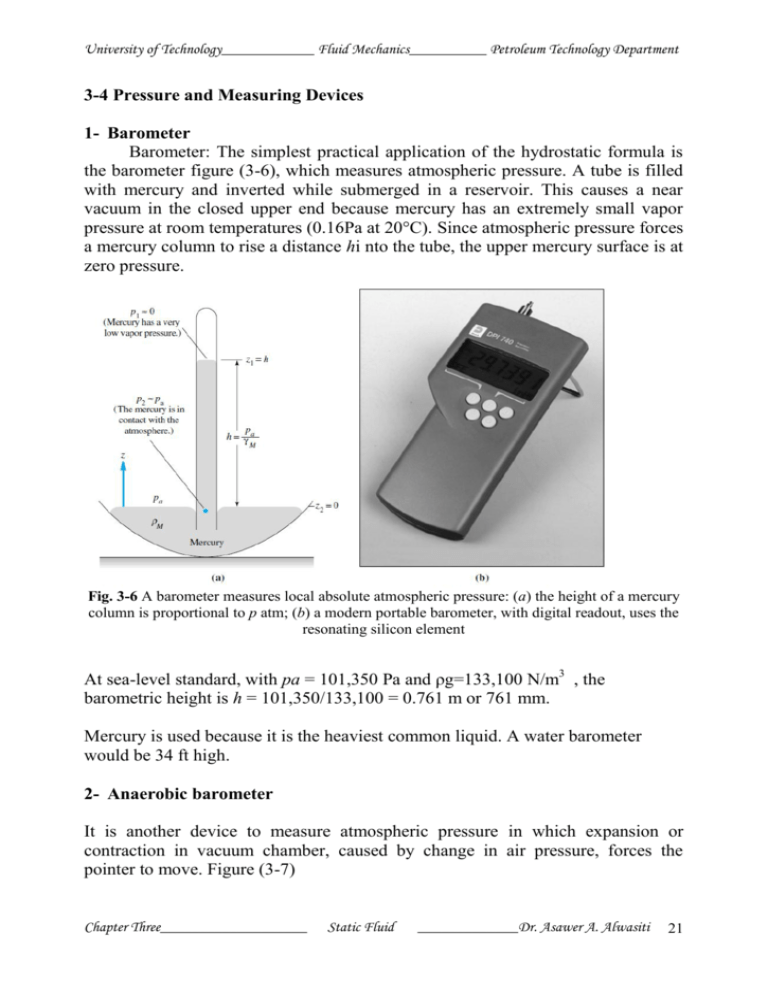
University of Technology____________ Fluid Mechanics__________ Petroleum Technology Department 3-4 Pressure and Measuring Devices 1- Barometer Barometer: The simplest practical application of the hydrostatic formula is the barometer figure (3-6), which measures atmospheric pressure. A tube is filled with mercury and inverted while submerged in a reservoir. This causes a near vacuum in the closed upper end because mercury has an extremely small vapor pressure at room temperatures (0.16Pa at 20°C). Since atmospheric pressure forces a mercury column to rise a distance hi nto the tube, the upper mercury surface is at zero pressure. Fig. 3-6 A barometer measures local absolute atmospheric pressure: (a) the height of a mercury column is proportional to p atm; (b) a modern portable barometer, with digital readout, uses the resonating silicon element At sea-level standard, with pa = 101,350 Pa and ρg=133,100 N/m3 , the barometric height is h = 101,350/133,100 = 0.761 m or 761 mm. Mercury is used because it is the heaviest common liquid. A water barometer would be 34 ft high. 2- Anaerobic barometer It is another device to measure atmospheric pressure in which expansion or contraction in vacuum chamber, caused by change in air pressure, forces the pointer to move. Figure (3-7) Chapter Three___________________ Static Fluid _____________Dr. Asawer A. Alwasiti 21 University of Technology____________ Fluid Mechanics__________ Petroleum Technology Department Fig (3-7): the anaerobic barometer 3- Manometers A manometer is a device for measuring fluid pressure consisting of a bent tube containing one or more liquids of different densities In manometer a known pressure (which may be atmospheric) is applied to one end of the manometer tube and the unknown pressure (to be determined) is applied to the other end The Differential pressure manometers measure only the difference between the two pressures There are many types of manometer: a- Simple manometer – Piezometer b- Simple U – tube manometer c- Inverted U – tube manometer d- U - tube with one leg enlarged (Well type manometer) e- Two fluid U – tube manometer f- Four-fluid U – tube manometer g- Inclined U – tube manometer a- Simple manometer – Piezometer It’s used to measure pressure in a static fluid by using the height of a column of liquid ( figure 3-8) pressure at point 1 = pressure at point 2 = pressure at point A P1 = PA+ ρgh Fig (3-8): The Pizometer Chapter Three___________________ Static Fluid _____________Dr. Asawer A. Alwasiti 22 University of Technology____________ Fluid Mechanics__________ Petroleum Technology Department b- Simple U – tube manometer It is used to measures the pressure at a point and consists of bent tube glass with one end exposed to atmosphere and the other attached to the fluid being measured(figure 3-9) PG= Patm+ ρLgh – ρGg(h+h,,) ≈ Patm+ ρLgh since ρL>>>ρG Fig.(3-9) Simple U-tube manometer c- Differential U – tube manometer It is used when difference between two pressures needed and consists of a transparent U-tube containing the fluid of density (ρ) whose pressure is to be measured and an immiscible fluid (m) of higher density (ρm). The limbs are connected to the two points between which the pressure difference (P2 - P1) is required The pressure at level x will be: Px = P1 + ρg (a+h) The pressure at level x’ will be: Px’ = P2 + ρm g h + ρ g a Since Px = Px’ ( at same level) Then P1 – P2 = (ρm – ρ ) gh Fig.(3-11): the Differential U – tube manometer There is other type of differential U – tube manometer like in figure (3-12). The configuration A suitable for large pressure differences and requires dense measuring fluid (e.g. mercury), while configuration B for small differences and Chapter Three___________________ Static Fluid _____________Dr. Asawer A. Alwasiti 23 University of Technology____________ Fluid Mechanics__________ Petroleum Technology Department needs light measuring fluid Fig(3-12) : Differential U – tube manometer d- Inverted U- Tube manometer It is used for measuring pressure differences in liquids. The space above the liquid in the manometer is filled with air, which can be admitted or expelled through the tap A in order to adjust the level of the liquid in the manometer.(figure 3-13) The pressure at level x will be: Px = P1 - ρg (a+h) The pressure at level x’ will be: P2 - ρm g h - ρ g a Since Px = Px’ ( at same level) Then P1 – P2 = (ρ - ρm) gh Fig.(3-13): Inverted U-tube manometer e- U - tube with one leg enlarged (Well type manometer) It is used to measure low pressures, where accuracy id of much importance.figure (3-14) The pressure difference is : ∆P = P1 –P2 = (ρm - ρ)hg Chapter Three___________________ Static Fluid _____________Dr. Asawer A. Alwasiti 24 University of Technology____________ Fluid Mechanics__________ Petroleum Technology Department Fig.(3-14): Well type manometer f- The inclined manometer Shown in Figure (3-15) enables the sensitivity of the manometers described previously to be increased by measuring the length of the column of liquid. If θ is the angle of inclination of the manometer (typically about 10-20°) and L is the movement of the column of liquid along the limb, then: hm = L sin θ If θ = 10°, the manometer reading L is increased by about 5.7 times compared with the reading hm which would have been obtained from a simple manometer. Fig.(3-15):The inclined manometer g- Two fluid U – tube manometer It is used for small pressure differences or accurate determination of large pressure difference (figure 3-16) ΔH occurs due to the pressure difference between 1, 2 Let p1 > p2 but small difference pa = pb using Fig.(3-16): Two fluid U – tube manometer Chapter Three___________________ Static Fluid _____________Dr. Asawer A. Alwasiti 25 University of Technology____________ Fluid Mechanics__________ Petroleum Technology Department h- Four-fluid U – tube manometer Fig.(3-16): Four fluid U – tube manometer 4- Mechanical Gage Whenever a very high fluid pressure is to be measured, and a very great sensitivity a mechanical gauge is best suited for these purposes. They are also designed to read vacuum pressure. A mechanical gauge is also used for measurement of pressure in boilers or other pipes, where tube manometer cannot be conveniently used. The Bourdon gauge The pressure to be measured is applied to a curved tube, oval in crosssection, and the deflection of the end of the tube is communicated through a system of levers to a recording needle. This gauge is widely used for steam and compressed gases, and frequently forms the indicating element on flow controllers. Chapter Three___________________ Static Fluid _____________Dr. Asawer A. Alwasiti 26 University of Technology____________ Fluid Mechanics__________ Petroleum Technology Department Fig.(3-17): Bourdon gauge 3-5 How to solve manometer problems? In general, follow the following steps when analyzing manometry problems: 1. On manometer schematic, label points on each end of manometer and each intermediate point where there is a fluid-fluid interface: e.g., A – 1 – 2 - B 2. Express overall manometer pressure difference in terms of appropriate intermediate pressure differences. PA - PB = (PA- P1) + (P1 – P2) + (P2 - PB ) 3. Express each intermediate pressure difference in terms of appropriate product of specific weight * elevation change (watch signs) PA- PB = - ρg(zA- z1) – ρg (z1 – z2) – ρg (z2 - zB ) 4. Substitute for known values and solve for remaining unknowns. When developing a solution for manometer problems, take care to: 1. Include all pressure changes 2. Use correct ∆Z and γwith each fluid 3. Use correct signs with ∆Z. If pressure difference is expressed as PA – P1, the elevation change should be written as ZA – Z1 4. Watch units. Chapter Three___________________ Static Fluid _____________Dr. Asawer A. Alwasiti 27 University of Technology____________ Fluid Mechanics__________ Petroleum Technology Department Example 1 Given the indicated manometer, determine the gage pressure at A. Given that Pa =101.3 kPa and the fluid at A is Meriam red oil no. 3. ρgw = 9790 N/m3 ρg A = S.G.*ρgw = 0.83*9790 N/m3 ρg A = 8126 N/m3 ρgair = 11.8 N/m3 Solution With the indicated points labeled on the manometer, we can write PA - Pa = (PA- P1) + (P1 – P2) + (P2 - Pa ) Substituting the manometer expression for a static fluid, we obtain PA - Pa = - ρgA(zA- z1) – ρgw(z1 – z2) – ρga(z2 - za ) Neglect the contribution due to the air column. Substituting values, we obtain PA - Pa = - 8126 N/m3 * 0.10 m – 9790 N/m3 * -0.18 = 949.6 N/m2 Note why: (zA- z1) = 0.10 m and (z1 – z2) = -0.18 m, & did not use Pa Example 2 Pressure gage B is to measure the pressure at point A in a water flow. If the pressure at B is 87kPa, estimate the pressure at A, in kPa. Assume all fluids are at 20°C. Solution pA = 96,351 Pa = 96.4 kPa Example 3 The following Figure shows a manometer connected to the pipeline containing oil of sp.gr. 0.8. Determine the absolute pressure of the oil in the pipe, and the gauge pressure. Chapter Three___________________ Static Fluid _____________Dr. Asawer A. Alwasiti 28 University of Technology____________ Fluid Mechanics__________ Petroleum Technology Department Example 4 The following Figure shows a compound manometer connected to the pipeline containing oil of sp.gr. 0.8. Calculate Pa. Example 5 A differential manometer is connected to two pipes as shown in Figure. The pipe A is containing carbon tetrachloride sp.gr. = 1.594 and the pipe B is contain an oil of sp.gr. = 0.8. Find the difference of mercury level if the pressure difference in the two pipes be 0.8 kg/cm2. Example 6 A differential manometer is connected to two pipes as shown in Figure. At B the air pressure is 1.0 kg/cm2 (abs), find the absolute pressure at A. Chapter Three___________________ Static Fluid _____________Dr. Asawer A. Alwasiti 29 University of Technology____________ Fluid Mechanics__________ Petroleum Technology Department Example 7 Determine the specific weight of the fluid. Example 8 In the following both the tank and the tube are open to the atmosphere. If L = 2.13 m, what is the angle of tilt θ of the tube? Example 9 For the inverted manometer of Figure below, all fluids are at 20°C. If pB _ pA _ 97 kPa, what must the height H be in cm? Chapter Three___________________ Static Fluid _____________Dr. Asawer A. Alwasiti 30

